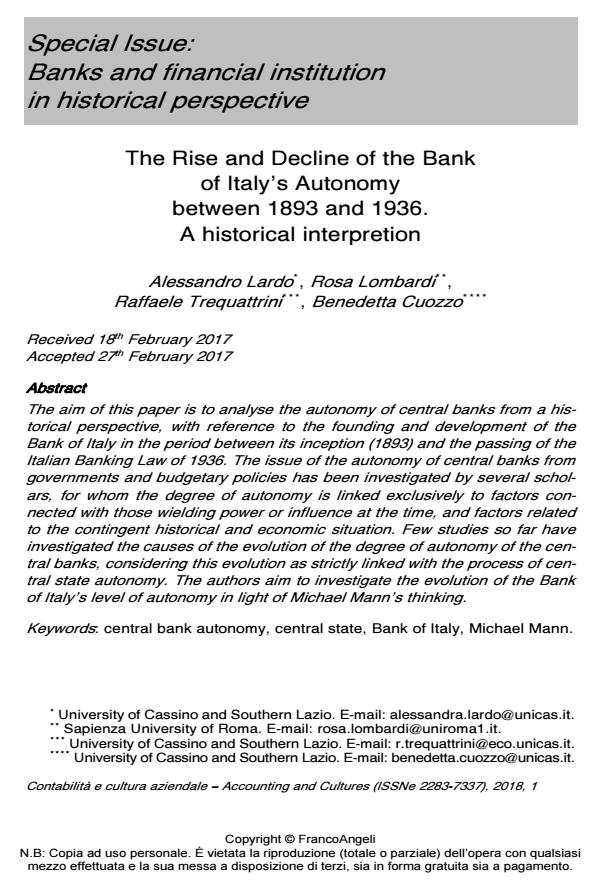The Rise and Decline of the Bank of Italy’s Autonomy between 1893 and 1936. A historical interpretion
Journal title CONTABILITÀ E CULTURA AZIENDALE
Author/s Alessandro Lardo, Rosa Lombardi, Raffaele Trequattrini, Benedetta Cuozzo
Publishing Year 2018 Issue 2018/1
Language English Pages 23 P. 13-35 File size 240 KB
DOI 10.3280/CCA2018-001003
DOI is like a bar code for intellectual property: to have more infomation
click here
Below, you can see the article first page
If you want to buy this article in PDF format, you can do it, following the instructions to buy download credits

FrancoAngeli is member of Publishers International Linking Association, Inc (PILA), a not-for-profit association which run the CrossRef service enabling links to and from online scholarly content.
The aim of this paper is to analyse the autonomy of central banks from a historical perspective, with reference to the founding and development of the Bank of Italy in the period between its inception (1893) and the passing of the Italian Banking Law of 1936. The issue of the autonomy of central banks from governments and budgetary policies has been investigated by several scholars, for whom the degree of autonomy is linked exclusively to factors connected with those wielding power or influence at the time, and factors related to the contingent historical and economic situation. Few studies so far have investigated the causes of the evolution of the degree of autonomy of the central banks, considering this evolution as strictly linked with the process of central state autonomy. The authors aim to investigate the evolution of the Bank of Italy’s level of autonomy in light of Michael Mann’s thinking.
Keywords: Central bank autonomy, central state, Bank of Italy, Michael Mann.
- Industry self-regulatory institutions, accounting and imitation mechanisms: the case of the ‘Unione Commercianti in Manifatture di Milano’ Carmelo Marisca, Gustavo Barresi, Nicola Rappazzo, in Accounting History Review /2022 pp.31
DOI: 10.1080/21552851.2022.2089703 - Banks and financial institutions in historical perspective Valerio Antonelli, Nieves Carrera, Christopher Napier, in CONTABILITÀ E CULTURA AZIENDALE 1/2018 pp.9
DOI: 10.3280/CCA2018-001002
Alessandro Lardo, Rosa Lombardi, Raffaele Trequattrini, Benedetta Cuozzo, The Rise and Decline of the Bank of Italy’s Autonomy between 1893 and 1936. A historical interpretion in "CONTABILITÀ E CULTURA AZIENDALE" 1/2018, pp 13-35, DOI: 10.3280/CCA2018-001003